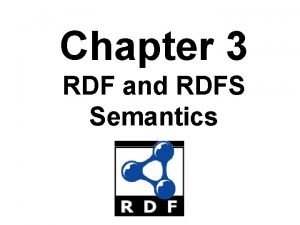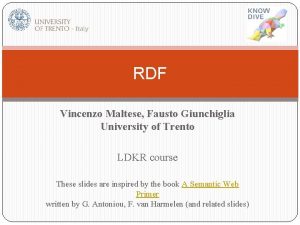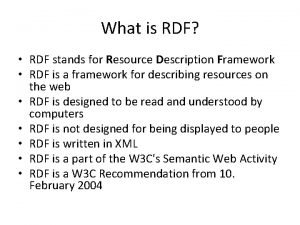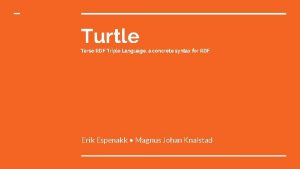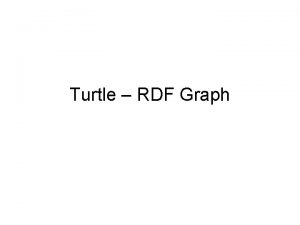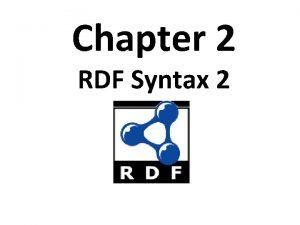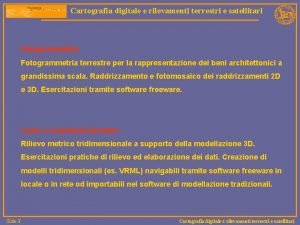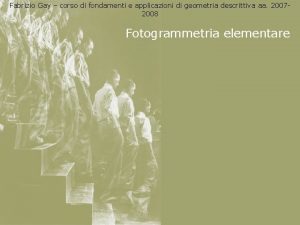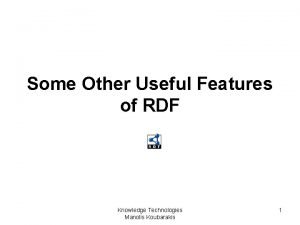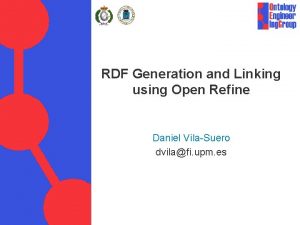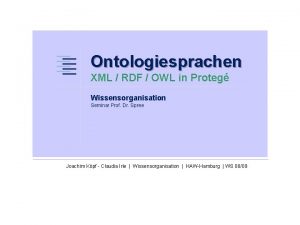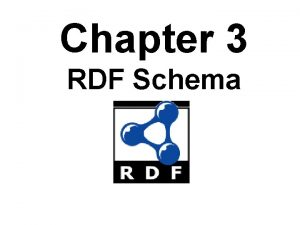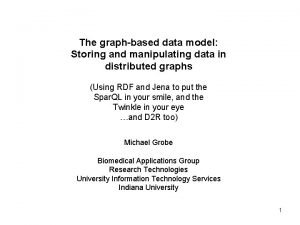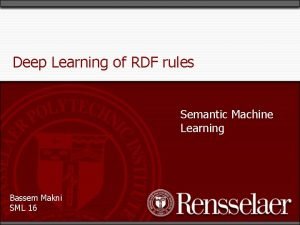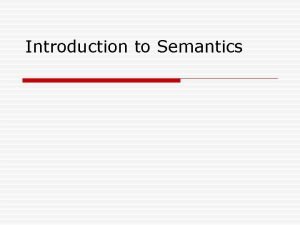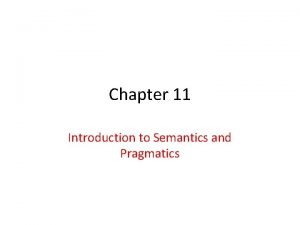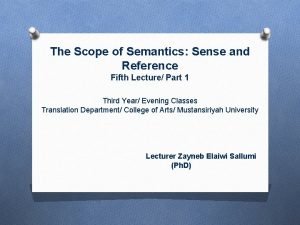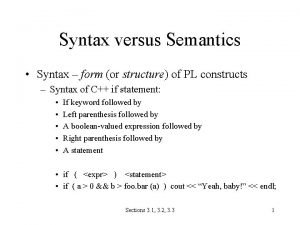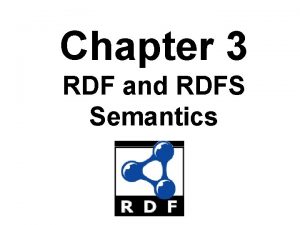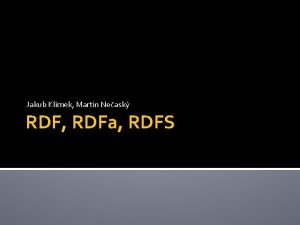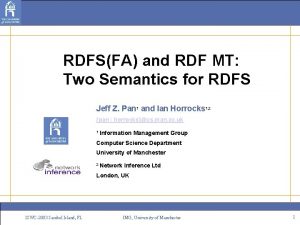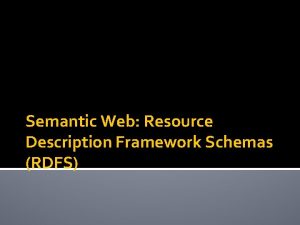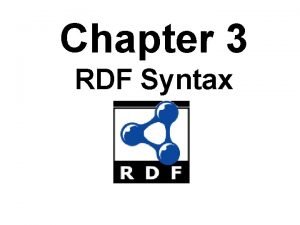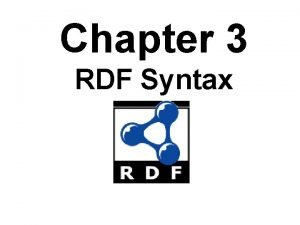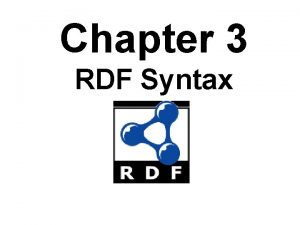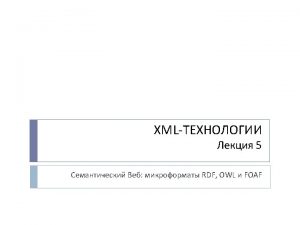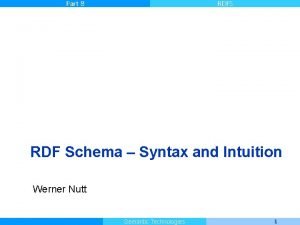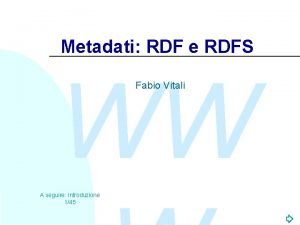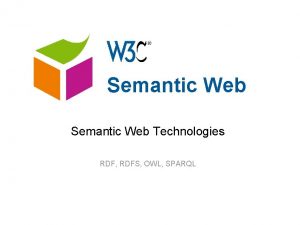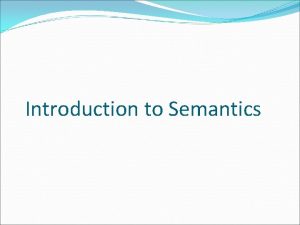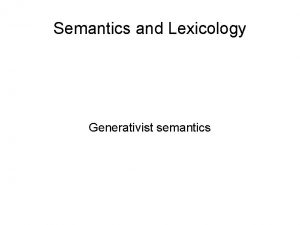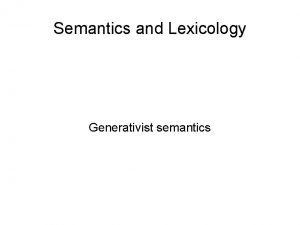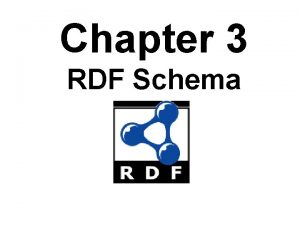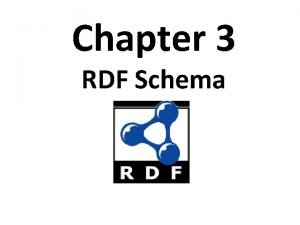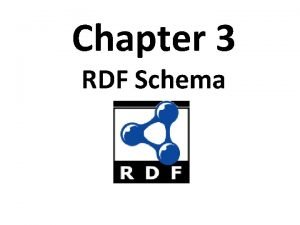Chapter 3 RDF and RDFS Semantics Introduction l




















- Slides: 20

Chapter 3 RDF and RDFS Semantics

Introduction l RDF has a very simple data model l But it is quite liberal in what you can say l Semantics can be given using axiomatically – – relating it to another representation, e. g. , first order logic, for which a semantic model exists May result in an executable semantics l Semantics (MT) can be given by RDF Model Theory

RDF/RDFS “Liberality” l No distinction between classes and instances (individuals) <Species, type, Class> <Lion, type, Species> <Leo, type, Lion> l Properties can themselves have properties <has. Daughter, sub. Property. Of, has. Child> <has. Daughter, type, family. Property> l No distinction between language constructors and ontology vocabulary, so constructors can be applied to themselves/each other <type, range, Class> <Property, type, Class> <type, sub. Property. Of, sub. Class. Of>

Semantics and model theories l Ontology/KR languages aim to model (part of) world l Terms in language correspond to entities in world l MT defines relationship between syntax and interpretations – – Can be many interpretations (models) of one piece of syntax Models supposed to be analogue of (part of) world l – Formal relationship between syntax and models l – e. g. , elements of model correspond to objects in world structure of models reflect relationships specified in syntax Inference (e. g. , subsumption) defined in terms of MT l e. g. , T ² A v B iff in every model of T, ext(A) µ ext(B)

Set Based Model Theory l Many logics (including standard FOL) use a model theory based on Zermelo-Frankel set theory l The domain of discourse (i. e. , the part of the world being modelled) is represented as a set (often referred as ) l Objects in the world are interpreted as elements of – Classes/concepts (unary predicates) are subsets of – Properties/roles (binary predicates) are subsets of (i. e. , 2) – Ternary predicates are subsets of 3 etc. l The sub-class relationship between classes can be interpreted as set inclusion l Doesn’t work for RDF, because in RDF a class (set) can be a member (element) of another class (set) – In Z-F set theory, elements of classes are atomic (no structure)

Set Based Model Theory Example World Model Interpretation Daisy is. A Cow kind. Of Animal Mary is. A Person a Person kind. Of Animal Z 123 ABC is. A Car Mary drives Z 123 ABC b {<a, b>, …}

Set Based Model Theory Example l Formally, the vocabulary is the set of names we use in our model of (part of) the world {Daisy, Cow, Animal, Mary, Person, Z 123 ABC, Car, drives, …} l An – – interpretation I is a tuple h , ¢I i is the domain (a set) ¢I is a mapping that maps l Names of objects to elements of l Names of unary predicates (classes/concepts) to subsets of l Names of binary predicates (properties/roles) to subsets of l And so on for higher arity predicates (if any)

RDF Semantics l RDF has “Non-standard” semantics in order to deal with this l Semantics given by RDF Model Theory (MT) l In RDF MT, an interpretation I of a vocabulary V consists of: – IR, a non-empty set of resources (corresponds to ) – IS, a mapping from V into IR (corresponds to ¢I ) – IP, a distinguished subset of IR (the properties) l – IEXT, a mapping from IP into the powerset of IR l – A vocabulary element v V is a property iff IS(v) IP I. e. , property elements mapped to subsets of IR IL, a mapping from typed literals into IR

Example RDF Simple Interpretation

RDF Semantic Conditions l l RDF Imposes semantic conditions on interpretations, e. g. : – x is in IP if and only if <x, IS(rdf: Property)> is in IEXT(I(rdf: type)) All RDF interpretations must satisfy certain axiomatic triples, e. g. : – rdf: type rdf: Property – rdf: subject rdf: type rdf: Property – rdf: predicate rdf: type rdf: Property – rdf: object rdf: type rdf: Property – rdf: first rdf: type rdf: Property – rdf: rest rdf: type rdf: Property – rdf: value rdf: type rdf: Property – …

Example RDF Interpretation

RDFS Semantics l RDFS simply adds semantic conditions and axiomatic triples that give meaning to schema vocabulary l Class interpretation ICEXT simply induced by rdf: type, i. e. : – l l x is in ICEXT(y) if and only if <x, y> is in IEXT(IS(rdf: type)) Other semantic conditions include: – If <x, y> is in IEXT(IS(rdfs: domain)) and <u, v> is in IEXT(x) then u is in ICEXT(y) – If <x, y> is in IEXT(IS(rdfs: sub. Class. Of)) then x and y are in IC and ICEXT(x) is a subset of ICEXT(y) – IEXT(IS(rdfs: sub. Class. Of)) is transitive and reflexive on IC Axiomatic triples include: – rdf: type rdfs: domain rdfs: Resource – rdfs: domain rdf: Property

RDFS Interpretation Example l If RDFS graph includes triples <Species, type, Class> <Lion, type, Species> <Leo, type, Lion> <Lion, sub. Class. Of, Mammal > <Mammal, sub. Class. Of, Animal> l Interpretation conditions imply existence of triples <Lion, sub. Class. Of, Animal> <Leo, type, Mammal> <Leo, type, Animal> …

RDFS Axioms l Another way to define the semantics of RDF and RDFS is to give axioms that relate it to well understood representation, such as FOL, that has a formal semantics. l A benefit of this approach is that the axioms may provide the basis of an “executable semantics” l For a list of FOL axioms (in N 3) defining RDFS vocabulary, see – http: //www. csee. umbc. edu/691 m/n 3/rdfs-rules. n 3

RDFS Inference Rules {? S ? P ? O} => {? P a rdf: Property}. {? P rdfs: domain ? C. ? S ? P ? O} => {? S a ? C}. {? P rdfs: range ? C. ? S ? P ? O} => {? O a ? C}. {? S ? P ? O} => {? S a rdfs: Resource. ? O a rdfs: Resource}. {? Q rdfs: sub. Property. Of ? R. ? P rdfs: sub. Property. Of ? Q} => {? P rdfs: sub. Property. Of ? R}. {? P @has rdfs: sub. Property. Of ? R. ? S ? P ? O} => {? S ? R ? O}. {? C a rdfs: Class} => {? C rdfs: sub. Class. Of rdfs: Resource}. {? A rdfs: sub. Class. Of ? B. ? S a ? A} => {? S a ? B}. {? B rdfs: sub. Class. Of ? C. ? A rdfs: sub. Class. Of ? B} => {? A rdfs: sub. Class. Of ? C}. {? X a rdfs: Container. Membership. Property} => {? X rdfs: sub. Property. Of rdfs: member}. {? X a rdfs: Datatype} => {? X rdfs: sub. Class. Of rdfs: Literal}.

RDFS Classes rdf: Alt rdfs: sub. Class. Of rdfs: Container. rdf: Bag rdfs: sub. Class. Of rdfs: Container. Membership. Property rdfs: sub. Class. Of rdf: Property. rdfs: Datatype rdfs: sub. Class. Of rdfs: Class. rdf: Seq rdfs: sub. Class. Of rdfs: Container. rdf: XMLLiteral rdfs: sub. Class. Of rdfs: Literal; a rdfs: Datatype.

RDFS Properties rdfs: label rdfs: domain rdfs: Resource; rdfs: range rdfs: Literal. rdfs: comment rdfs: domain rdfs: Resource; rdfs: range rdfs: Literal. rdfs: see. Also rdfs: domain rdfs: Resource; rdfs: range rdfs: Resource. rdfs: is. Defined. By rdfs: domain rdfs: Resource; rdfs: range rdfs: Resource; rdfs: sub. Property. Of rdfs: see. Also. -- rdfs: domain rdf: Property; rdfs: range rdfs: Class. rdfs: range rdfs: domain rdf: Property; rdfs: range rdfs: Class. -- rdf: first rdfs: domain rdf: List; rdfs: range rdfs: Resource. rdf: rest rdfs: domain rdf: List; rdfs: range rdf: List. rdfs: member rdfs: domain rdfs: Container; rdfs: range rdfs: Resource. -- rdfs: sub. Class. Of rdfs: domain rdfs: Class; rdfs: range rdfs: Class. rdfs: sub. Property. Of rdfs: domain rdf: Property; rdfs: range rdf: Property. -- rdf: subject rdfs: domain rdf: Statement; rdfs: range rdfs: Resource. rdf: object rdfs: domain rdf: Statement; rdfs: range rdfs: Resource. rdf: predicate rdfs: domain rdf: Statement; rdfs: range rdf: Property. -- rdf: type rdfs: domain rdfs: Resource; rdfs: range rdfs: Class. rdf: value rdfs: domain rdfs: Resource; rdfs: range rdfs: Resource.

RDFS individuals rdfs: first a owl: Functional. Property. rdfs: rest a owl: Functional. Property rdf: nil a rdf: List.

Problems with RDFS l RDFS – No localised range and domain constraints l – Can’t say that all instances of person have a mother that is also a person, or that persons have exactly 2 parents No transitive, inverse or symmetrical properties l – Can’t say that the range of has. Child is person when applied to persons and elephant when applied to elephants No existence/cardinality constraints l – too weak to describe resources in sufficient detail Can’t say that is. Part. Of is a transitive property, that has. Part is the inverse of is. Part. Of or that touches is symmetrical … l Difficult – – to provide reasoning support No “native” reasoners for non-standard semantics Possible to reason via FO axiomatisation

Conclusions l RDF has a very simple data model l But it is quite liberal in what you can say l Semantics can be given using axiomatically – – relating it to another representation, e. g. , first order logic, for which a semantic model exists May result in an executable semantics l Semantics (MT) can be given by RDF Model Theory
 Rdfs semantics
Rdfs semantics Rdfs shipping
Rdfs shipping Compare procedural semantics and declarative semantics.
Compare procedural semantics and declarative semantics. Wikipedida
Wikipedida Subjekt predikat objekt
Subjekt predikat objekt Syntax
Syntax Ontology schema
Ontology schema Rdf list example
Rdf list example Raddrizzamento fotogrammetrico
Raddrizzamento fotogrammetrico Rdf raddrizzamento download
Rdf raddrizzamento download Who made this statement
Who made this statement Openrefine rdf extension
Openrefine rdf extension Rdf owl
Rdf owl Rdf
Rdf Rdf
Rdf Ontology rdf
Ontology rdf Rdf machine learning
Rdf machine learning Conceptual semantics
Conceptual semantics Introduction to semantics
Introduction to semantics Sense and reference linguistics
Sense and reference linguistics Syntax vs semantics
Syntax vs semantics
